| Pages:
1
2
3 |
Vosoryx
Hazard to Others
  
Posts: 282
Registered: 18-6-2017
Location: British Columbia, Canada
Member Is Offline
Mood: Serial Apple Enjoyer
|
|
My findings on the ammonium carbonate test. (I also posted this on to the propylene carbonate thread on the organic chemistry forum)
I was curious to see if it was indeed ammonium carbonate, so decided to run a test utilizing the low MP of ammonium carbonate.(54 C)
I put some of the powder I had in a beaker in a water bath with a thermometer, and turned on the heat. It passed 54, and the water started bumping
quite heavily around 80. I was worried about dislodging the beaker from my lab stand, so I turned down the temp and tried to keep it in the 75-85 C
range for about 10 minutes. (Just to make sure the inside of the beaker came up to temperature.) When poked, the material crumbled slightly easier
than when it is cold, but did not melt. I believe that is evidence against the ammonium carbonate theory.
I will try this with an oil bath in the future to see at what point it does melt at.
I am also working on redoing the distillation. Should be posted here tomorrow.
|
|
|
Oscilllator
National Hazard
   
Posts: 659
Registered: 8-10-2012
Location: The aqueous layer
Member Is Offline
Mood: No Mood
|
|
That's very interesting Vosoryx. Normally I would suggest testing if it's urea by heating with sodium hydroxide to see if any ammonia gas came off,
but I don't think this would be a good test in this instance as it could easily provide a false positive. Do any other members know of a more
selective test for urea?
|
|
|
Tellurium
Hazard to Self
 
Posts: 84
Registered: 12-7-2017
Location: Group 16, Chalcogen City
Member Is Offline
Mood: smelly
|
|
One way to test for urea is to heat it to around 140°C (this converts the suspected urea into biuret) and then do the Biuret test using Sodium
hydroxide and Copper sulfate.
This test indicates even the presence of small amounts of urea, but also indicates small amounts of proteins/peptides, but I strongly doubt them to be
in there.
A more specific way to test for urea is to bring some of the unknown substance into solution and add a little bit of phenolphthalein. The solution
should not be pink at this moment, but when adding the enzyme urease it converts the urea to ammonium carbonate, which makes the PH higher and causes
the solution to go pink.
|
|
|
subskune
Hazard to Self
 
Posts: 71
Registered: 30-4-2017
Member Is Offline
Mood: No Mood
|
|
Vosoryx replied to my short report of making propylene carbonate and made me aware of this thread. Maybe I can help someone with it. Here is the link:
http://www.sciencemadness.org/talk/viewthread.php?tid=75332
|
|
|
Harristotle
Hazard to Others
  
Posts: 138
Registered: 30-10-2011
Location: Tinkerville
Member Is Offline
Mood: I tink therefore I am
|
|
Very impressive.
Nice write up too.
What do you think, Oscillator?
Boiling point is a bit low, perhaps an azeotrope with an impurity, but still looks good.
Do we have/need another simple test for identity?
|
|
|
Vosoryx
Hazard to Others
  
Posts: 282
Registered: 18-6-2017
Location: British Columbia, Canada
Member Is Offline
Mood: Serial Apple Enjoyer
|
|
My final success. (Faliure.)
I finally had time to do the distillation. First, I tried a mineral oil bath, but it started boiling at about 120C (The temp of the bath, not the temp
of the stillhead.) I guess exact brand (From the superstore) mineral oil isn't good enough. Then, I tried a thinner sand bath, which worked amazingly
well. With only about 1 cm of sand between the pot and the RBF, and sand packed along the sides, the temp rose quite nicely. It passed the water BP
point with nothing coming over, (I distilled it all out last time) and then I kept it at around 200C until no more distillate came over. I switched
out the receiver for a clean one, and my remaining fluid came over. I was dismayed to find that it was still amber in colour, and even more when I
discovered how little of it there was, clearly disqualifying me on the >100mls rule. Picture of the two distillates, side by side. (PG on the
right, PC on the left.)
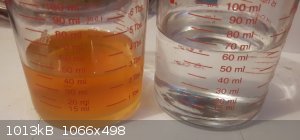
The condenser ended up filling up (again) with the mystery crystal, but the trap didn't seem to be capturing any ammonia, (The bubbles didn't dissolve
into solution the way that I know ammonia does.) but I honestly wasn't giving it my full attention.
Doing the math, I can see that I would have to repeat the reflux 2 more times to get >100mls of PC, and (Just ignoring the cost of PG, the
chemicals required to make ZnO, electricity and my own time) I would want to try to increase my yield with a vacuum pump. As a vacuum pump is below a
hotplate on my list of tools to acquire, I think I'm probably done trying.
I will try to remove the orange colour of the polymerized PC later, but I just wanted to do the update here. (I think activated charcoal, as described
in the PC thread on the organic chemistry forum, should work. Am I wrong?)
Good luck to whoever else tries this challenge.
|
|
|
Oscilllator
National Hazard
   
Posts: 659
Registered: 8-10-2012
Location: The aqueous layer
Member Is Offline
Mood: No Mood
|
|
It's not quite clear from your post whether you tried another run of the experiment or distilled the stuff from a previous run, but it's a nice effort
regardless. Did you make any effort to dry your reagents like subskune suggested? Anhydrous Magnesium sulphate is quite cheap and works well. That
might also be a cause of the orange colour.
With regards to the 100ml requirement, it's much less important than the purity requirement. If you get a bit under 100ml but can show that it is
reasonably pure then I'd let that pass. Also as an alternative to a vacuum pump you could use an aspirator. I bought one online for like 20 bucks an
it works OK for this although it does use a lot of water.
|
|
|
subskune
Hazard to Self
 
Posts: 71
Registered: 30-4-2017
Member Is Offline
Mood: No Mood
|
|
In my case the aspirator trap worked very well. It caught all the ammonia and left me with a lot of ammonium sulfate. That amber colour means that you
either refluxed too long or destilled too long (to dryness). If you use the quantities I described you should leave ~ 60ml behind. Activated charcoal
helps to remove impurities but only to a certain degree. Destillate that dark I once had was not recoverable. But it might be worth a try.
The ZnO is really the smallest problem. I did 200g once and this will last forever. You really need to do larger quantitied this is way more
controllable during destillation in large flasks.
This is REALLY useful to get a purer product: http://www.sciencemadness.org/talk/viewthread.php?tid=63013
[Edited on 22-7-2017 by subskune]
|
|
|
CalAm
Harmless

Posts: 28
Registered: 7-7-2016
Location: Australia
Member Is Offline
Mood: No Mood
|
|
I am going to give this a go this saturday / sunday as my PG arrived today. 
|
|
|
Oscilllator
National Hazard
   
Posts: 659
Registered: 8-10-2012
Location: The aqueous layer
Member Is Offline
Mood: No Mood
|
|
I look forward to your efforts CalAm. If you can I would suggest drying your PG somehow before your conduct the reaction, as this may affect the
formation of the mystery white substance.
|
|
|
Vosoryx
Hazard to Others
  
Posts: 282
Registered: 18-6-2017
Location: British Columbia, Canada
Member Is Offline
Mood: Serial Apple Enjoyer
|
|
I used activated carbon and (Anhydrous) MgSO4 to dry and clean the material that I had at the end. Both materials absorbed some of the PC, and some of
the MgSO4 passed through the filter and turned the liquid green, and both the carbon and MgSO4 were quite wet with the PC. In the end I had only 6mls
left, of a very green coloured liquid. I abandoned that route and tried again with my last PG. Everything was the same as the last time I did it, so
i'm not going to show the two reflux's and the distillation, except that this time I stopped as soon as the reaction started to colour orange. When I
did the distillation I got much more PG than the previous time, and then added in some carbon, let it sit for some time, and then put through a proper
filter. My final yield was 15 Mls and has the density of PG. (Wikipedia says PC is at 1.205 g/cm^3) and I measured, on my very crappy scale, 1.15
g/cm^3.
I also agree with the description of the scent being "Burned urea." It smells startlingly similar at first.
It's a bit off colour though, slightly more yellow than proper PC, or even some of the other ones I have seen here, with a very slight brown/orange
tint.
Attachment: phpO6m9ib (885kB)
This file has been downloaded 860 times Attachment: phpInpLLA (569kB)
This file has been downloaded 727 times Attachment: phpQikbS2 (737kB)
This file has been downloaded 842 times
|
|
|
subskune
Hazard to Self
 
Posts: 71
Registered: 30-4-2017
Member Is Offline
Mood: No Mood
|
|
honestly, that is looking way better the density og pg is 1.06 so you are in between which serms to be quite frequent at high temp destillations. on
the other hand with some patince and a loss you can catch the 238c - 242c fraction. (if you wonder why i stick to 238, my thermometer has an
inaccuracy of +-3c at these temps.
|
|
|
Vosoryx
Hazard to Others
  
Posts: 282
Registered: 18-6-2017
Location: British Columbia, Canada
Member Is Offline
Mood: Serial Apple Enjoyer
|
|
I'm sure there is an azeotrope of PG and PC here. I would do the entire process again, but I'm out of PG and am honestly a bit tired of smelling
ammonia. My mercury thermometer has the same inaccuracy, and I switched out the receivers when the temp at the still head was around 230. (There was
nothing coming over above 200 anyway)
I'm also pretty sure my crappy scale is highly inaccurate at measuring tiny changes in weight, so my density calculation could be off.
I don't really have any motivation to try it again, and even less to buy more PG. I suppose I could use the stuff I recovered in the distillation, but
I know it's contaminated with ammonia (I can smell that) so it probably also contains other by-products that might mess up the reaction.
Have you tried this CalAm? Even if you didn't get the desired product, I'd love to know how it went for other people.
|
|
|
subskune
Hazard to Self
 
Posts: 71
Registered: 30-4-2017
Member Is Offline
Mood: No Mood
|
|
Yeah, I can understand, ammonia sucks. Thats why I used an acid trap. This avoided any ammonia smell. I needed 5 runs until I had optimized all. To
start this and not to run out of reactants I bought 5kg urea, 5l PG and made 200g ZnO. All together this was 25€, which is quite acceptable. Precise
measurment equipment is a must! One ml or one g off can change you density form 1.2 to 1.17.
|
|
|
Vosoryx
Hazard to Others
  
Posts: 282
Registered: 18-6-2017
Location: British Columbia, Canada
Member Is Offline
Mood: Serial Apple Enjoyer
|
|
That's very impressive for the price you bought your chemicals for. I could have bough 2L of PG for $60 CAD. (~40 euro for less than half as much.
Instead, I opted to just buy some of the stuff online.) Urea, which I removed from instant cold packs, is pretty cheap, and I made the ZnO myself with
zinc I took out of zinc-carbon batteries.
I could consider doing it again if I had the reagents cheaper. You're lucky wherever you live.
|
|
|
Vosoryx
Hazard to Others
  
Posts: 282
Registered: 18-6-2017
Location: British Columbia, Canada
Member Is Offline
Mood: Serial Apple Enjoyer
|
|
I tried this one last time with the PG I recovered from the distillation, and I re-dried my urea in the oven. I guess the PG (Which stank of ammonia)
contained water. I was checking it every five minutes or so, coming out from my house to my shed. I saw a lot of solid accumulating in the condenser,
much more than before, so I was worried that it would plug. When I came out next the flask and condenser were full of water, and the ammonia trap I
had set up was quite low on water. Here's my theory:
The condenser plugged, and the joint between my flask and the condenser didn't pop, (Unfortunately) so the vapours above the block in the condenser
cooled and dropped in pressure enough to suck some of my ammonia trap water back into the condenser through the take off adapter at the top, which
instantly washed the solid out and unblocked the condenser. The water siphoned into my flask and condenser. I tried to boil it down, but that proved
difficult. The bumping kept splashing water out of the E. flask, so I decided to call it quits after all.
Is the offer still open? Should I buy more PG and try again?
|
|
|
Harristotle
Hazard to Others
  
Posts: 138
Registered: 30-10-2011
Location: Tinkerville
Member Is Offline
Mood: I tink therefore I am
|
|
My end is, but we have agreed between us that Oscillator will judge, as it was his proposal and work that brought this to a contest. Make him happy,
and I will pay!
Cheers,
Harristotle
|
|
|
Vosoryx
Hazard to Others
  
Posts: 282
Registered: 18-6-2017
Location: British Columbia, Canada
Member Is Offline
Mood: Serial Apple Enjoyer
|
|
I was ready to give this up, until I found out that my work (Aquaculture) buys Propylene Glycol by the literal bucket load, and, let's just say they
didn't notice a litre going missing.
Attachment: phptcYtn4 (499kB)
This file has been downloaded 861 times
So I tried this again, and got another completely different result. All reagents were dried using anhydrous magnesium sulphate. Once I refluxed it for
about 2 hours, I set up a distillation around the flask. I distilled over the tiny amount of water, then a large amount of PG over a bit of time. The
receiving flask turned yellow as the distillation continued, and the Erlenmeyer flask's contents turned a deeper and deeper red.
Attachment: phpz3bS94 (1MB)
This file has been downloaded 868 times Attachment: phpwEeSFq (1.1MB)
This file has been downloaded 870 times
Attachment: phpci6InI (605kB)
This file has been downloaded 861 times
Eventually, the temperature at the stillhead started dropping, even though the flask still contained a liquid, and my hotplate was at max heat. I know
my crappy kitchen hotplate can reach well over 300 C, so I'm not sure why it did this. In the E. flask was left a slightly tarry deep red liquid with
the smell I have heard is around after the distillation of PC; Burned urea, slightly fruity.
I left it on the heat for almost half an hour, and the temp at the stillhead even reached as low as 80 C., with the hotplate on full. I'm trying this
again, and when I do I'll not let it reflux for as long.
For anyone who has tried this, is it just because I'm not getting hot enough to boil the PC? I had it wrapped in aluminum foil, all up to the
thermometer adapter. Another thought I had was to attach it to a crappy goodwill vacuum cleaner, as this might lower the pressure enough to help it
boil without the required 244 C. (Which my hotplate should be able to reach anyway) The vacuum also might help pull off the ammonia during the reflux.
Perhaps that would help reduce by-products?
I have kept everything from the distillation, on both sides, just if anyone can offer any suggestions on how to get the PC out.
On a completely different note: I'm not sure why this post has my pictures in the downloaded link form, where I have posted others and they show up as
pictures within the post.
Suggestions on any of my many problems?
Thanks.
|
|
|
subskune
Hazard to Self
 
Posts: 71
Registered: 30-4-2017
Member Is Offline
Mood: No Mood
|
|
Vosoryx, you must be really desperate to own a hotplate stirrer that you even "steal" pg from your employee
Now to your attempt:
- How do you know that you collected only water and pg? Whats your temperature data?
- Yes temperature is a problem! Its a balancing act. If you use too much aperatus, everything will polymerize and decompose before anything came over
BECAUSE at this high temperatures every inch of glassware is a superior condenser, which makes your destillation essentially a reflux. If your plate
is too hot you might destroy the mixture at the contact point. I didn't do it but a heating mantle would be perfect. If you don't have one, insulate.
Pack in AL first to reflect the IR radiation. Then pack all in fibreglass or if you have no, kitchen towel. Use a MINIMUM AMOUNT OF GLASSWARE for the
destillation. If you can pull a vac do it.
- Did you pull vacuum during reflux? This is crucial!
The erlenmeyer residue looks horrible, toss it.
Everything else: Measure density and decide whether there is enough pc in it for another destillation.
|
|
|
CalAm
Harmless

Posts: 28
Registered: 7-7-2016
Location: Australia
Member Is Offline
Mood: No Mood
|
|
Sorry for the disappearance i am now on a 2 week break with uni so i should be able to finally give this an attempt. I do think i will need to order a
bit more PG though after looking at the previous attempts as i only have 250ml or 400ml to have a shot at this.
|
|
|
Vosoryx
Hazard to Others
  
Posts: 282
Registered: 18-6-2017
Location: British Columbia, Canada
Member Is Offline
Mood: Serial Apple Enjoyer
|
|
If you do it well you only need one shot.
My advice: Use a vacuum, even if it's just the pull from a vacuum cleaner, especially during the reflux. Good luck!
|
|
|
Vosoryx
Hazard to Others
  
Posts: 282
Registered: 18-6-2017
Location: British Columbia, Canada
Member Is Offline
Mood: Serial Apple Enjoyer
|
|
Finally! A success!
Bump!
It's been an interesting past few months. As soon as my last attempt failed gloriously, I decided a vacuum pump was a necessity, and so ordered an
aspirator online along with a 12v pump. The pump took two months to ship, so when it finally arrived I was ecstatic and exited to get back out and try
this - only to have my condenser shatter on me. Three weeks later, here I am. In the time all that was happening, I also got gifted a nice heating
mantle for my birthday. It seems I now have every piece of lab equipment I could use except a hotplate stirrer.
I have no idea if the offer is still open, or if you've passed it on. However, your initial goal of increasing the community has worked - this thread
turned me from a lurker to a user, and that has turned into me coming here daily.
So here is my latest attempt.
The urea, propylene glycol, and zinc oxide was mixed together in an RBF. A reflux was setup, and the heating mantle and vacuum pump was turned on. An
hour later, i turned off heat and set up for a distillation, and distilled under vacuum. All the fractions < 210 C (My vac isn't that strong) was
discarded, and the fraction from then up was collected. It was about 25 mLs.
The density was recorded as being 1.17 g/mL. Theoretical is 1.21.
This could be because my scale isn't great, which it isn't - I'll weigh some on my schools balance, which does this: 00.0000g on Monday, but I think
it's more likely that it is contaminated with some leftover propylene glycol. I considered re-distilling, but due to the large amount of dead-space in
24/40 glassware, and the fact that I don't have that PC much to begin with, I decided against it. If a higher purity is needed, i'll go ahead and make
another batch so i have enough to do a distillation and to separate the PC from the PG unless anyone else has a method for separating the two?
Pics below, and a link to a yt video for some of the videos I took.
https://www.youtube.com/watch?v=1t-J1QGbupw
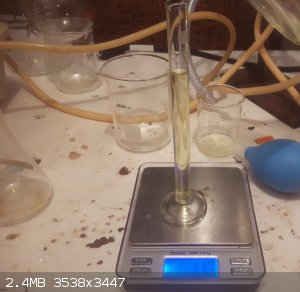
Density proof.
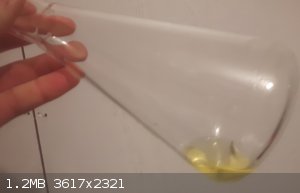
My distillate of PC.
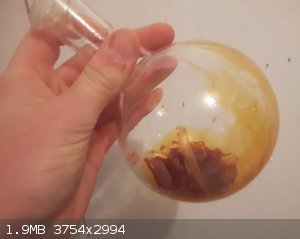
Remnants left in the RBF, along with the boiling stones included to prevent bumping. Bumping proved to be a serious issue, and I had to stop the
distillation at one point to put them in. I probably could have squeezed a bit more of the product out of this, but I cut it short anyway.
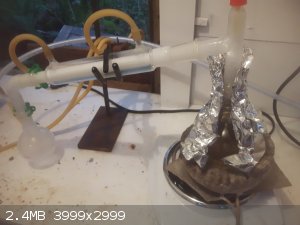
The flask during distillation. As you can see, the vacuum pump unfortunately did not prevent the ammonium carbonate from forming. This sucks, (Vacuum
puns!) because that was a major motivation for me getting the pump.
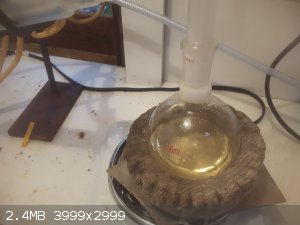
The flask was left in after the reflux. For some reason, these photos are going backwards in time... Go figure.
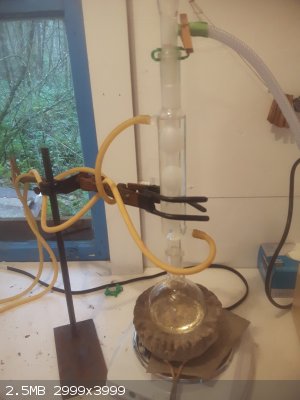
Picture during the reflux.
I'd like to make enough of it so that I can do a mass distillation to purify it. As I said, i'm concerned about how much I would lose if I were to
distill my only 20 mLs. If I had 100 mLs, then I would be outside distilling it, not posting this now.
I have the glassware and chemicals required to do a large batch, because I hate doing lots of small batches. However, I fear that the ammonium
carbonate would fill up and plug the condenser. Without someway of removing that, i'm stuck doing lots if little batches, which is not my favourite
idea. The time it takes is a major consideration. I try my best to have a life outside chemistry, however much my attempts at a life fail.
Thoughts?
|
|
|
Harristotle
Hazard to Others
  
Posts: 138
Registered: 30-10-2011
Location: Tinkerville
Member Is Offline
Mood: I tink therefore I am
|
|
Nice job. Are you close to 100ml yet?
It seems you are getting close to nailing it.
Cheers,
H.
|
|
|
Pupper
Harmless

Posts: 16
Registered: 14-11-2017
Location: STRAYA
Member Is Offline
Mood: No Mood
|
|
Quote: Originally posted by Oscilllator  | I've still only received two requests. I'm surprised, I thought there were more Aussies here!
Melgar to address your point, I'm not sure it's easier to do chemistry in America. I think there might be a bit of a "grass is greener on the other
side" mentality here but I always got the impression that places like Texas had very strict laws, although zts16 seems to get along just fine.
Personally I never had any big problems doing chemistry in Australia and generally managed to find the same OTC chemicals that Americans could with
some notable exceptions, namely isopropyl alcohol. |
Where do you get your chemicals? I can't find stuff like sulfuric acid etc
|
|
|
Vosoryx
Hazard to Others
  
Posts: 282
Registered: 18-6-2017
Location: British Columbia, Canada
Member Is Offline
Mood: Serial Apple Enjoyer
|
|
Harristotle: Yeah i need to try it again to get enough, probably after christmas because of how busy I am. The Ammonium Carbonate is a serious
problem, as I get afraid when doing large batches that the condenser will plug itself.
Pupper:
It takes looking to find the good ones. Sulphuic acid, for example, can be bought impure as SOME types of drain cleaner. Make sure it says sulphuric
acid on it though.
There's a nice useful OTC list that works well as a starting place for beginners, here:
https://en.wikipedia.org/wiki/List_of_commonly_available_che...
As a last resort, though sometimes an expensive one, order online.
|
|
|
| Pages:
1
2
3 |